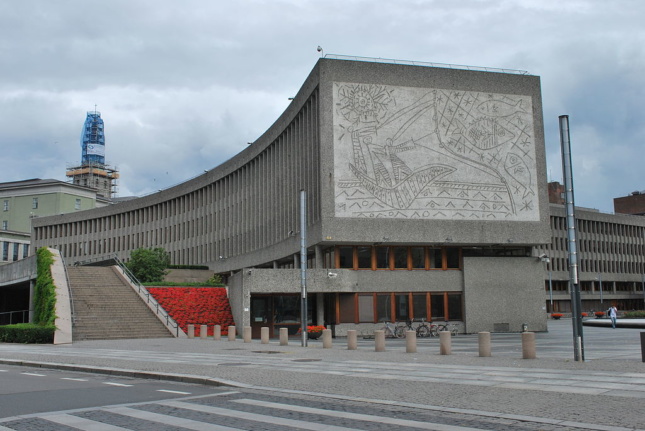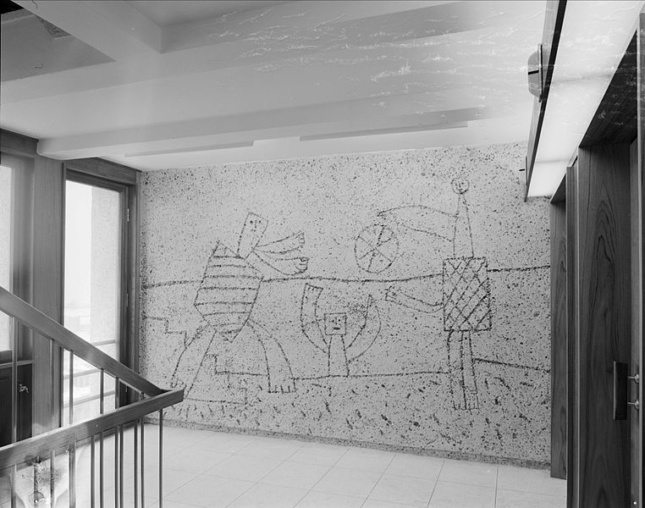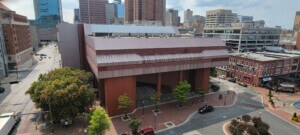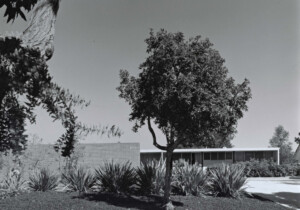After several years of delay, officials have announced that they will begin razing a 51-year-old governmental office building in Oslo near the site of a 2011 car bombing that rocked the Norwegian capital’s Regjeringskvartalet district.
The demolition of a office block that stands as a painful reminder of a horrific domestic terrorist attack—the worst in modern Norwegian history—may not seem, at first thought, to be an immediate cause for controversy. But the building is a significant one, a “monument of European importance,” per British preservation group Twentieth Century Society (C20).
Dubbed Y-Block, the striking 1969 designed structure, designed by modernist architect Erling Viksjø, features two murals by Pablo Picasso sandblasted onto its concrete walls—a first for the Spanish painter and sculptor in this medium. One is a monumental relief named The Fisherman that graces the building’s facade facing the bustling street Akersgata. A second smaller work, The Seagull, is located in the lobby.
Demolition-ready government officials have vowed to save and relocate the murals, which were executed by Picasso’s frequent collaborator, the Norwegian artist Carl Nesjar. Preservationists near and far, however, are crying foul. They believe that the building itself should also be spared from the wrecking ball.
The planned demolition has effectively been at a standstill since 2014 due to a series of postponements as the powers that be and preservationists hold their respective grounds. However, as Agence-France Press (AFP) reports, a request to enact another postponement was dismissed by the Norwegian government last week. Officials “argued that further delays would lead to financial cost as well as the postponement of the reconstruction project which has already been decided.”

“The whole idea of the area is precisely that the art is incorporated into the body of the building,” Mari Hvattum, a professor of architectural history and theory at the Oslo School of Architecture and Design, told the New York Times in a 2017 story about the push to preserve the building in its entirety.
Calling Y-Block “an architecture with just astonishing qualities,” Hvattum equated separating the murals from the building to removing a painting displayed in a museum from its frame. “A completely atrocious idea,” she said in 2017.
Those rallying against the demolition of Y-Block also believe that leveling the building, which would be replaced with a new governmental complex incorporating Picasso’s murals, would be finishing the job, so to speak, for Anders Behring Breivik, the right-wing extremist behind the 2011 attack. “We don’t want the ministry to tear down the building when the terrorist didn’t manage to do that,” Janne Wilberg, the city of Oslo’s director of cultural heritage, told the Times.
“Breivik wanted to attack social democracy,” elaborated Hvattum. “He wanted to get rid of the legacy of social democracy in built form, and in living form, in terms of people. To tear this down is to complete his [Breivik’s] mission.”

Just a month prior to the attack, it was announced that the Y-Block and the High Rise Block, or H-Block, an adjacent 1958 building also designed by Viksjø and boasting three small interior murals by Picasso and Nesjar, were to be listed as national heritage monuments. That process was halted.
Formal plans to demolish Y-Block—but carefully salvage its Picasso murals—as part of a larger reconstruction effort at Regjeringskvartalet were first announced by the Norwegian government three years after the attack. This was met with fierce opposition. (The idea was initially floated the previous year, 2013, and received a similarly heated response from preservationists and divided the general public.) Norwegian officials, as they continue to do, cited security concerns and the steep financial burden associated with allowing the unoccupied building to stand.
In a statement announcing the recent decision to move ahead with the demolition, it was revealed that Statsbygg, the agency charged with overseeing the Norwegian government’s real estate assets, had been handed the “assignment to start preparation work for the demolition of the Y-Block.” A firm date for the demolition has not been announced.
Unlike the Y-Block, officials have promised to spare the H-Block and eventually restore it. It too sustained light, non-structural damage in the 2011 attack although it has since been partially repopulated.
In 2015, heritage organization Europa Nostra placed Y-Block’s murals on a shortlist of Europe’s seven most endangered artworks. While Picasso and Nesjar collaborated on numerous other projects together across the world, most are freestanding sculptures as noted by C20, which believes that removing the murals at Y-Block would be “detrimental to the artistic integrity of the work.’ The duo completed two other innovative concrete murals outside of Oslo but only “The Fisherman” and a mural at the Official College of Architects of Catalonia in Barcelona are viewable by the public.
“The Highrise and The Y-block constitute a unified whole, where the buildings mutually enhance each other, and create an interesting space between them,” wrote C20 in 2016. “Both exteriors and interiors have walls made from sandblasted concrete with river gravel, a poetic local variation of the brutalist architecture of the time. The Y-block’s iconic shape, combined with the pioneering use of concrete and Picasso’s art, make it a building of exceptional value.”
More recently, Europa Nostra has backed efforts to save Y-Block itself, placing the building on the shortlist for the 2020 edition of its “7 Most Endangered” program.
“At a time when climate concerns are causing all of us to question how we can reduce our environmental impact, demolishing a perfectly sound building would be a waste of carbon in the energy consumed in demolition and in lost materials,” said Graham Bell, a member of Europa Nostra’s board and the 7 Most Endangered Advisory Panel, in a statement.
The Picasso Administration, the organization that oversees the artist’s vast legacy, was also initially skeptical of the decision to relocate the murals but has reportedly since softened its stance according to the Times.
“The Y-block is now, more than ever, a symbol for humankind and democracy,” reads a 2019 petition launched to save the building. “If it is taken away, a part of the history will be lost that cannot be replaced or withdrawn.”











